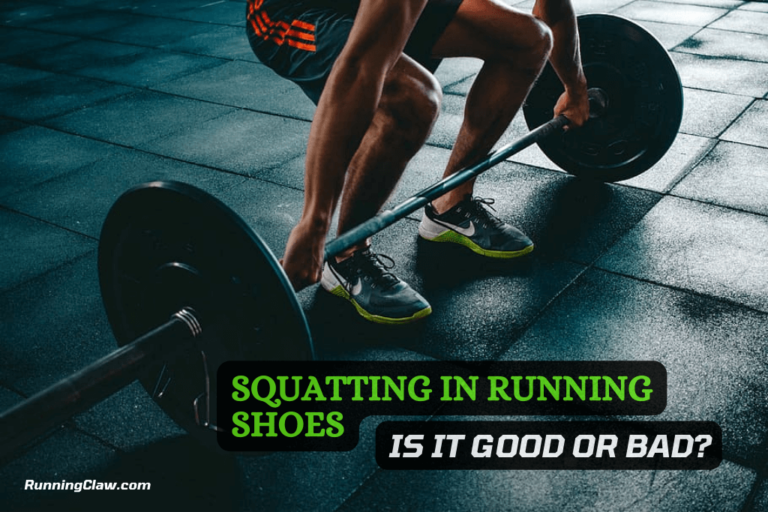If you are looking for squatting in running shoes then So your search is absolutely here. Running Shoes are ideal for Running and Walking activities. Moreover, they are the best choice for doing Gym exercises. Many people use Running Shoes for Gym Exercises as well.
Table of Contents
BUT!!! Only for a Few Exercises.
I have seen many youngsters wearing Running Shoes for Weight exercises and Squatting.
Is it OK to wear Running Shoes for Squatting?
Or,
Are Running Shoes Ideal for Weightlifting?
I have guided all of this in my article. So Read the whole article. I hope it is Worth Reading.
Squat Shoes Vs. Running Shoes
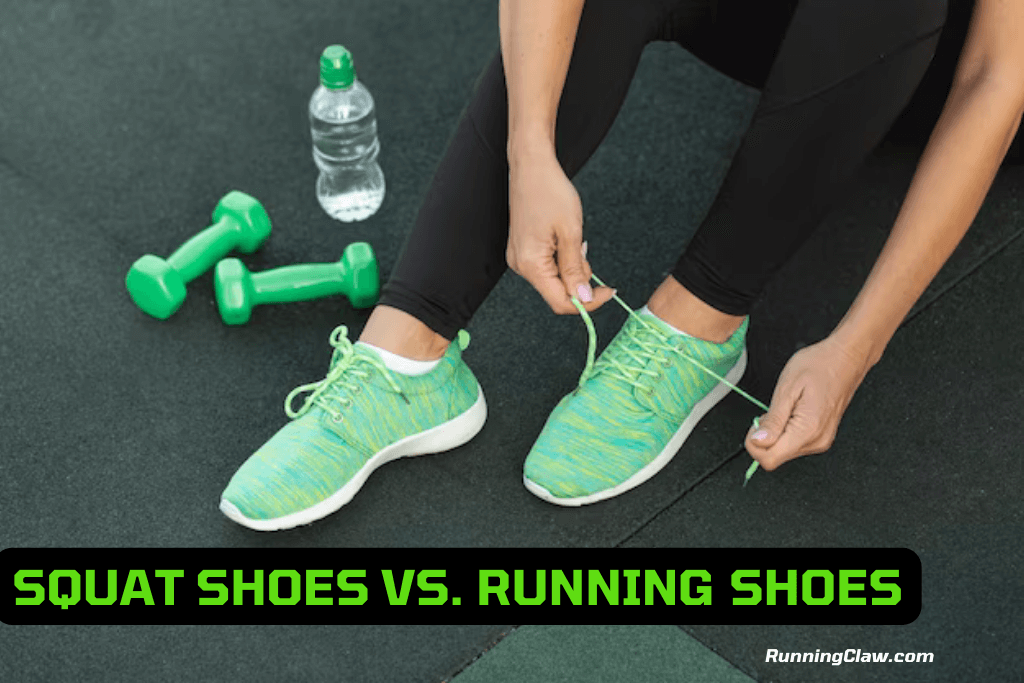
Here is a Head-to-Head Key Comparison between Running Shoes and Squat Shoes.
Heel Raise:
One similarity between squat shoes and running shoes is a higher heel.
However, their mechanics serve two entirely distinct purposes. So, even though they may appear similar, they have a few significant distinctions.
It’s better to have a heel rise in a running shoe, but it’s unnecessary. It’s usually combined with a toe-drop ratio to give good arch support.
The raised heel in running shoes is designed to help improve your bouncing motion when you run. Oh, and it also works as a cushion to help prevent heel pain.
Regarding squat shoes, the heels are really important for how they work. By using a slight heel rise, you can give your ankles a break from flexing too much when you’re at the bottom of a squat. And That’s great!
It helps when you’re working out and want to do squats with the whole movement while staying stable.
Structure:
When you pick up a running shoe, you’ll notice it’s light and flexible. Flexibility is essential if you want to sprint as fast as possible without weighing your feet too much.
The shoe feels light because it’s made with EVA foam and breathable mesh fabric. These materials make up most of the shoe’s structure.
By the way, squat shoes are typically made of synthetic leather, making them a bit heavier. This will help you feel more “grounded” on the floor when lifting heavier weights during squats.
These shoes typically have tough soles made of rubber that don’t bend easily.
Squat shoes are designed to be durable since they’re meant to handle a lot more weight than your typical running shoe.
Arch Support:
Let’s talk about Arch Support.
Running shoes typically feature sufficient arch support to assist you if you experience foot pain after walking or running for an extended period.
It is generally recommended that squat shoes have minimal arch support, as the curved design of the soles could potentially lead to balance issues while performing the lift.
However, if you have flat feet, you may consider opting for a squat shoe offering minimal arch support.
Traction and Outsole:
Hey Dude, Traction and a comfortable Outsole are two important characteristics Shoes have.
Are You trying to lift a barbell with many heavyweights while wearing slippery shoes? That’s just asking for trouble! Oh, and you know what? Running shoes have this slip-resistant outsole, but sometimes they feel a bit loose. The heavy traction on the outsole can slow you down while running.
While squat shoes are great! They’re made with perfect traction materials that stay in place and help prevent slipping. They use non-slip traction pods and synthetic rubber to ensure you stay steady during your squats.
Is it Good to Wear Running Shoes for Squats?
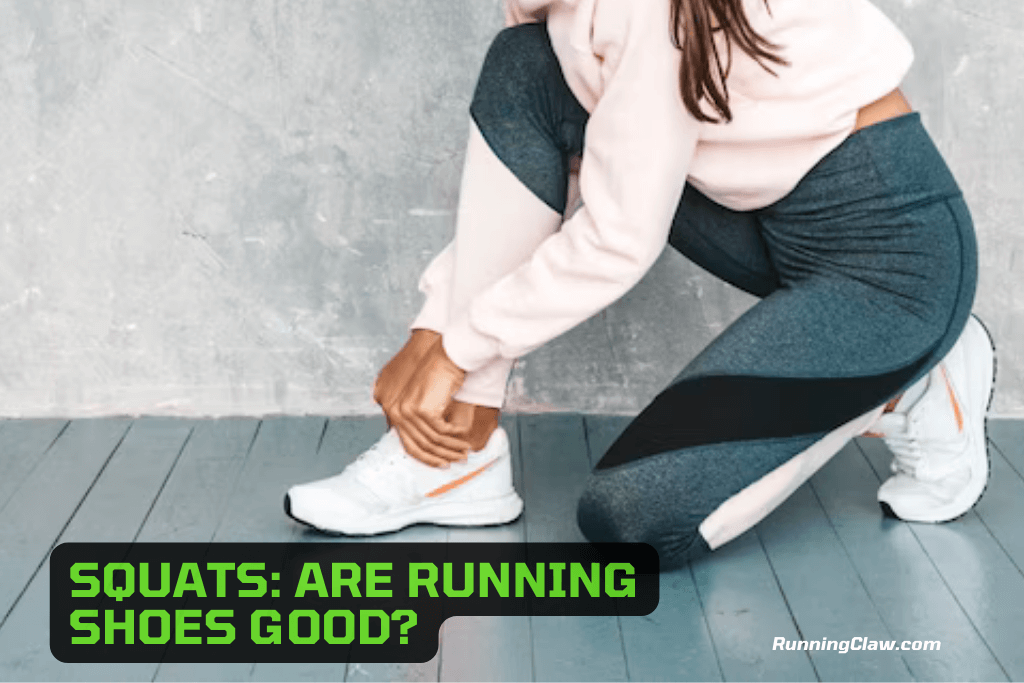
It’s generally not recommended to wear running shoes for squats, to get the most out of your workout and stay safe. Running shoes are awesome because they’re made to give you cushioning and support specifically for moving forward.
They’re great at absorbing the impact of each step and keeping you comfy while running or taking a nice walk. When it comes to squats, where you’re lifting heavy weights and need excellent balance and proper biomechanics, there might be better options than running shoes.
Squatting in running shoes is bad for the following reasons:
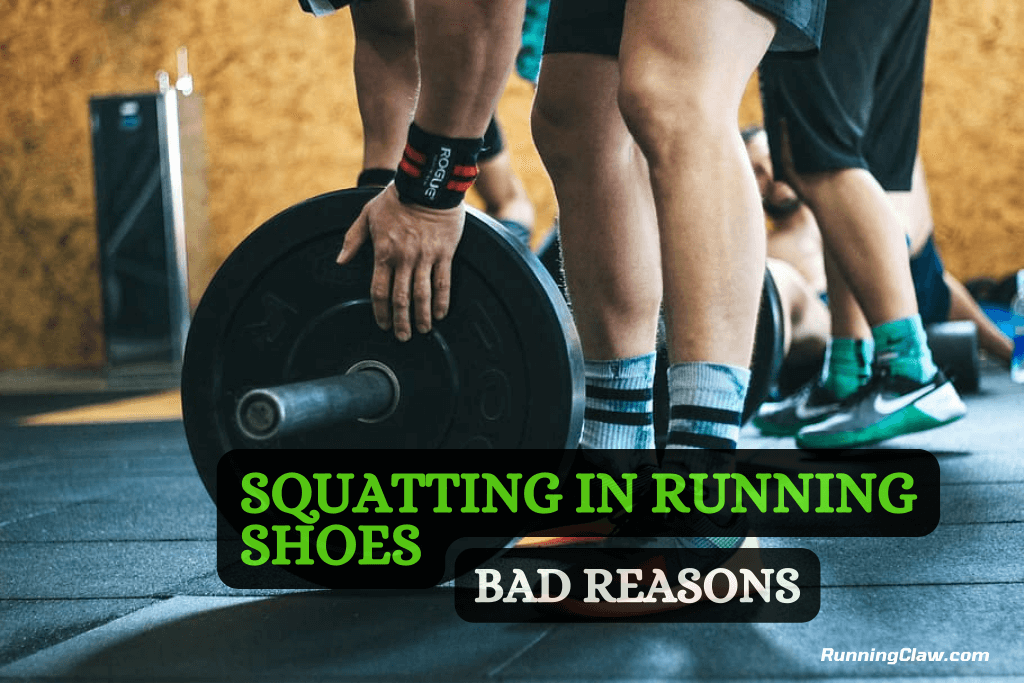
Here are some reasons you shouldn’t Squat in Running Shoes.
Lack of Foot Stability and Balance:
It is logical to assume that a lifter would have reduced balance and stability when wearing running shoes with spongy soles, compared to squat shoes or even being barefoot.
A spongy sole can interfere with the capacity to plantarflex (press the ball of the feet onto the ground) during upward movement or dorsiflex (put weight onto the heels) during downward movement. The change in mechanics introduces a potential risk of injury due to the possibility of losing balance and falling.
Consider this: imagine yourself squatting on a floor constructed entirely of sponge material. In this scenario, your feet would effectively sink into the sponge, creating a noticeable indentation. The running shoe consists of a cushioned material that provides a layer of support between the foot and the ground.
Squat Depth Is Too Shallow
Many lifters struggle with squat depth because they don’t have good proprioception.
Well, this point can differ from person to person. Some weightlifters might find that running shoes with a raised heel help them maintain better form, especially if they have limited ankle mobility.
However, for the most part, the raised heel in running shoes only gives you a little extra height to help with squat depth.
Lack of Technical Feedback
So the thing about running shoes is that they’re not great for lifting because they make it harder to “feel the floor.” But you know, it’s important to have a solid foundation so you can get feedback on your technique quickly and make any necessary adjustments.
The primary explanation for this. They’re not very stable on their feet when they start moving.
My Experience:
Well, my friend, I am now sharing my experience with you. Once, I went to the gym and started Squatting. I forgot that I was wearing Running Shoes. I did a complete session of 40 Minutes. When I went home, I had a lot of pain in Heels.
And from that day onwards, I never wore Running Shoes for Squats.
FAQ’s
Is it Better to Squat with a Belt or Without?
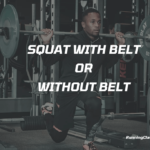
If you wear a belt while doing squats, the shear forces on your spine will be less, making it less likely that you will get hurt. It has also been shown that belts can make your core and leg muscles work harder, making your training more effective.
Can I Use Running Shoes for Gym?
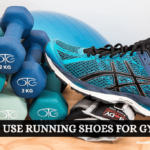
Running sneakers are the best for gym training if you do 30 minutes on a running machine and a few mat movements.
Conclusion:
Ultimately, I would never recommend you wear Running Shoes for Squats because it is a Worse Idea to Wear Running for Squats.
If you wear Running Shoes for Squats, be ready for A Lot of Trouble because Running Shoes aren’t Ideal for Squats.
Related Articles:
- Winger in Soccer
- How to Make Cleats Smell Better?
- What Sports Can Use Metal Cleats?
- Soccer Cleats Vs. Football Cleats
- Can Soccer Cleats Be Used for Football?
- Do Professional Soccer Players get Free Cleats?
- Can Soccer Cleats Be Used for Football?
- Do Puma Soccer Cleats Have A Warranty?
- What is The Difference Between Shoes and Cleats?
- Difference Between Soccer and Football Cleats


